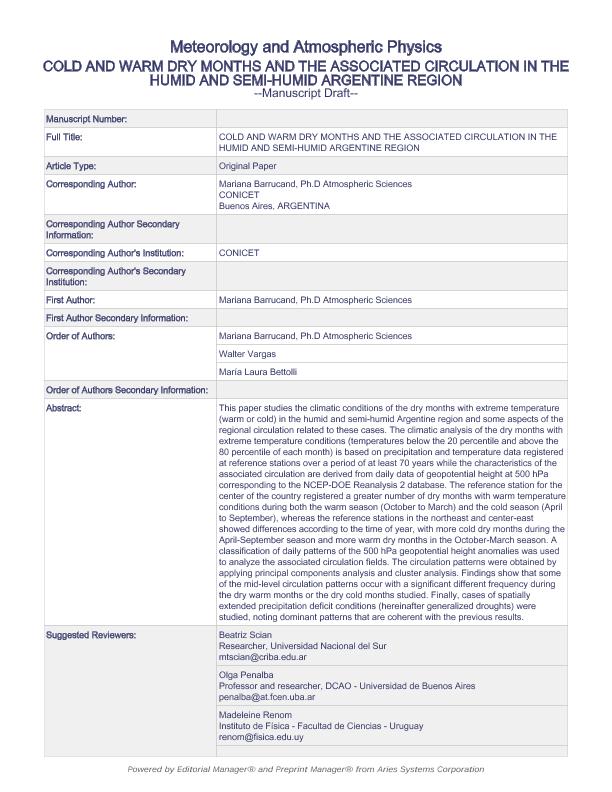Artículo
Warm and cold dry months and associated circulation in the humid and semi-humid Argentine region
Fecha de publicación:
02/2014
Editorial:
Springer Wien
Revista:
Meteorology and Atmospheric Physics
ISSN:
0177-7971
e-ISSN:
1436-5065
Idioma:
Inglés
Tipo de recurso:
Artículo publicado
Clasificación temática:
Resumen
This paper studies the climatic conditions of warm and cold dry months in the humid and semi-humid Argentine region and some aspects of the regional circulation related to these cases. The climatic analysis of warm (temperatures above percentile 80) and cold (temperatures below percentile 20) dry months is based on precipitation and temperature data registered at reference stations over a period of at least 70 years, while the associated circulation is derived from daily data of geopotential height at 500 hPa from NCEP-DOE Reanalysis 2 database. The reference station for the center of the country registered a greater number of warm dry months during both the warm season (October–March) and the cold season (April–September), whereas the reference stations in the north-east and center-east showed differences depending on the time of the year, with more cold dry months during the April–September season and more warm dry months in the October–March season. A classification of daily fields of geopotential height anomalies at 500 hPa was used to analyze the atmospheric circulation related to warm and cold dry months. The circulation patterns were obtained by applying principal component analysis and cluster analysis. Findings show that some mid-level circulation patterns occur with a significant different frequency during the warm dry months or the cold dry months studied. Finally, cases of spatially extended precipitation-deficit conditions (hereinafter generalized droughts) were studied, noting dominant patterns that are coherent with the previous results.
Palabras clave:
Sequia
Archivos asociados
Licencia
Identificadores
Colecciones
Articulos(OCA CIUDAD UNIVERSITARIA)
Articulos de OFICINA DE COORDINACION ADMINISTRATIVA CIUDAD UNIVERSITARIA
Articulos de OFICINA DE COORDINACION ADMINISTRATIVA CIUDAD UNIVERSITARIA
Citación
Barrucand, Mariana Graciela; Vargas, Walter Mario; Bettolli, Maria Laura; Warm and cold dry months and associated circulation in the humid and semi-humid Argentine region; Springer Wien; Meteorology and Atmospheric Physics; 123; 3; 2-2014; 143-154
Compartir
Altmétricas




